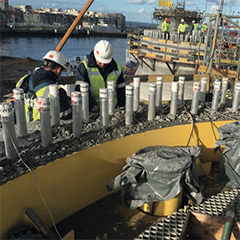Is there anything that can be done to prevent or protect against corrosion? This is a question which preoccupies many in our industry. There are many types of corrosion, which in fact is a natural process, so it seems it’s like trying to hold back the tide. Is there anything that we mere humans can do to stop it? Jo van Montfort, director and coating specialist at Bjond, gives PES his expertise and thoughts on ‘atmospheric corrosion’.
What is corrosion?
As all material in the universe strives to return to its lowest energy state, pure metals, such as steel also strive to revert to their lowest energy state, which they were as sulphides or oxides. All man-made structures disintegrate until the lowest energy content is reached. A well-known example of this is corroding or rusting of steel, in which the energy that is supplied to make the steel out of ore is released again and the material disintegrates into rust.
Unprotected, unalloyed steel or carbon steel exposed to a marine environment gets back to where it came from unless we add energy to it. This can be done e.g. by applying a protective coating for the parts above the water line. These parts are mainly exposed to what is defined as ‘atmospheric corrosion’.
What is ‘atmospheric corrosion’?
Carbon steel corrosion is mainly determined by the environment to which the steel is exposed. In the case of offshore structures, the dominant type of corrosion above the waterline and in the splash-zone is so called ‘atmospheric corrosion’. Under the water line other types of corrosion occur, such as e.g. microbiological induced corrosion.
Atmospheric corrosion of unalloyed steel is a generally defined as a uniform and local form of thickness loss that depends on the presence of water and oxygen at/on the steel surface. However, water films are not always visible, especially if an amount of rust has already been formed. Atmospheric corrosion can also occur locally depending on what is going on at the steel surface; contaminations, failing paint layers etc.
The corrosion product of steel: ‘rust’ is porous and voluminous, 7-9 times the volume of steel, and therefore well permeable to water and oxygen. This means that when we observe a corrosion layer of about 1 cm thick, approximately 1.4 – 1.1 mm of underlying steel is lost.






























